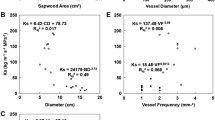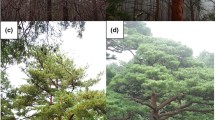Abstract
Because palms grow in highly varying climates and reach considerable heights, they present a unique opportunity to evaluate how environment and plant size impact hydraulic function. We studied hydraulic properties of petioles from palms of varying height from three species: Iriartea deltoidea, a tropical rainforest species; Mauritia flexuosa, a tropical rainforest, swamp species; and Washingtonia robusta, a subtropical species. We measured leaf areas, petiole cross-sectional areas, specific conductivity (K S), petiole anatomical properties, vulnerability to embolism and leaf water potentials and calculated petiole Huber values and leaf-specific conductivities (K L). Leaf and petiole cross-sectional areas varied widely with height. However, hydraulic properties including Huber values, K S and K L, remained constant. The two palmate species, M. flexuosa and W. robusta, had larger Huber values than I. deltoidea, a pinnately-compound species which exhibited the highest K S. Metaxylem vessel diameters and vascular bundle densities varied with height in opposing patterns to maintain petiole conductivities. I. deltoidea and W. robusta petioles had similar P 50 values (the point at which 50% of hydraulic conductivity is lost) averaged over all crown heights, but W. robusta exhibited more negative P 50 values in taller palms. Comparison of P 50 values with transpiring midday leaf water potentials, as well as a double-dye staining experiment in a 1-m-tall palm, suggested that a fairly significant amount of embolisms were occurring and refilled on a diurnal basis. Therefore, across palms differing widely in height and growing environments, we found convergence in water transport per unit leaf area (K L) with individuals exhibiting differing strategies for achieving this.





Similar content being viewed by others
References
Barnard HR, Ryan MG (2003) A test of the hydraulic limitation hypothesis in fast-growing Eucalyptus saligna. Plant Cell Environ 26:1235–1245
Burgess SSO, Pittermann J, Dawson TE (2006) Hydraulic efficiency and safety of branch xylem increases with height in Sequoia sempervirens (D.Don) crowns. Plant Cell Environ 29:229–239
Canny MJ (1997) Vessel contents during transpiration—embolisms and refilling. Am J Bot 84:1223–1230
Canny MJ (2001) Embolisms and refilling in the maize leaf lamina, and the role of the protoxylem lacuna. Am J Bot 88:47–51
Cochard H, Nardini A, Coll L (2004) Hydraulic architecture of leaf blades: where is the main resistance? Plant Cell Environ 27:1257–1267
Davis TA (1961) High root-pressures in palms. Nature 4799:277–278
Domec JC, Gartner BL (2003) Relationship between growth rates and xylem hydraulic characteristics in young, mature and old-growth ponderosa pine trees. Plant Cell Environ 26:471–483
Domec JC, Lachenbruch B, Meinzer FC, Woodruff DR, Warren JM, McCulloh KA (2008) Maximum height in a conifer is associated with conflicting requirements for xylem design. Proc Natl Acad Sci USA 105:12069–12074
Drake PL, Franks PJ (2003) Water resource partitioning, stem xylem hydraulic properties, and plant water use strategies in a seasonally dry riparian tropical rainforest. Oecologia 137:321–329
Dransfield J (1978) Growth form of rain forest palms. In: Tomlinson PB, Zimmermann MH (eds) Tropical trees as living systems. Cambridge University Press, New York, pp 247–268
Dufrene E, Saugier B (1993) Gas exchange of oil palm in relation to light, vapour pressure deficit, temperature and leaf age. Funct Ecol 7:97–104
Hacke UG, Sperry JS, Wheeler JK, Castro L (2006) Scaling of angiosperm xylem structure with safety and efficiency. Tree Physiol 26:689–701
Hölttä T, Cochard H, Nikinmaa E, Mencuccini M (2008) Capacitive effect of cavitation in xylem conduits: results from a dynamic model. Plant Cell Environ 32:10–21
Kasturi Bai KV, Rajagopal V (2000) Osmotic adjustment as a mechanism for drought tolerance in coconut (Cocos nucifera L.). Indian J Plant Physiol 5:320–323
Knoerr KR, Gay LW (1965) Tree leaf energy balance. Ecology 46:17–24
Kolb KJ, Sperry JS, Lamont BB (1996) A method for measuring xylem hydraulic conductance and embolism in entire root and shoot systems. J Exp Bot 47:1805–1810
Lovisolo C, Schubert A (2006) Mercury hinders recovery of shoot hydraulic conductivity during grapevine rehydration: evidence from a whole plant approach. New Phytol 172:469–478
Machado JL, Tyree MT (1994) Patterns of hydraulic architecture and water relations of two tropical canopy trees with contrasting leaf phenologies: Ochroma pyramidale and Pseudobombax septenatum. Tree Physiol 14:219–240
McCully ME (1999) Root xylem embolisms and refilling. Relation to water potentials of soil, roots, and leaves, and osmotic potentials of root xylem sap. Plant Physiol 119:1001–1008
Meinzer FC (2002) Co-ordination of vapour and liquid phase water transport properties in plants. Plant Cell Environ 25:265–274
Milburn JA (1996) Sap ascent in vascular plants: challengers to the cohesion theory ignore the significance of immature xylem and the recycling of Münch water. Ann Bot 78:399–407
Milburn JA, Davis TA (1973) Role of pressure in xylem transport of coconut and other palms. Physiol Plant 29:415–420
Milburn JA, Zimmermann MH (1977) Preliminary studies on sapflow in Cocos nucifera L. I. Water relations and xylem transport. New Phytol 79:535–541
Nardini A, Tyree MT, Salleo S (2001) Xylem cavitation in the leaf of Prunus laurocerasus and its impact on leaf hydraulics. Plant Physiol 125:1700–1709
Nardini A, Salleo S, Raimondo F (2003) Changes in leaf hydraulic conductance correlate with leaf vein embolism in Cercis siliquastrum L. Trees 17:529–534
Neufeld HS, Grantz DA, Meinzer FC, Goldstein G, Crisosto GM, Crisosto C (1992) Genotypic variability in vulnerability of leaf xylem to cavitation in water-stressed and well-irrigated sugarcane. Plant Physiol 100:1020–1028
Niinemets U, Portsmuth A, Tena D, Tobias M, Matesanz S, Valladares F (2007) Do we underestimate the importance of leaf size in plant economics? Disproportional scaling of support costs within the spectrum of leaf physiognomy. Ann Bot 100:283–303
Niklas KJ (1993) Testing ‘economy in design’ in plants: are the petioles and rachises of leaves ‘designed’ according to the principle of uniform strength? Ann Bot 71:33–41
Niklas KJ (1996) Differences between Acer saccharum leaves from open and wind-protected sites. Ann Bot 78:61–66
Parkhurst DF, Loucks OL (1972) Optimal leaf size in relation to environment. J Ecol 60:505–537
Patrick JW, Zhang W, Tyerman SD, Offler CE, Walker NA (2001) Role of membrane transport in phloem translocation of assimilates and water. Aust J Plant Physiol 28:695–707
Phillips N, Bond BJ, Ryan MG (2001) Gas exchange and hydraulic properties in the crowns of two tree species in a Panamanian moist forest. Trees 15:123–130
Prior LD, Eamus D (2000) Seasonal changes in hydraulic conductance, xylem embolism and leaf area in Eucalyptus tetrodonta and Eucalyptus miniata saplings in a north Australian savanna. Plant Cell Environ 23:955–965
Rees AR (1961) Midday closure of stomata in the oil palm Elaeis guineensis Jacq. J Exp Bot 12:129–146
Renninger HJ, Phillips N, Hodel DR (2009) Comparative hydraulic and anatomic properties in palm trees (Washingtonia robusta) of varying heights: implications for hydraulic limitation to increased height growth. Trees 23:911–921
Renninger HJ, Phillips N, Salvucci GD (2010) Wet- vs. dry-season transpiration in an Amazonian rain forest palm Iriartea deltoidea. Biotropica 42:470–478
Rich PM, Holbrook NM, Luttinger N (1995) Leaf development and crown geometry of two iriarteoid palms. Am J Bot 82:328–336
Ryan MG, Yoder BJ (1997) Hydraulic limits to tree height and tree growth. Bioscience 47:235–242
Sack L, Melcher PJ, Zwieniecki MA, Holbrook NM (2002) The hydraulic conductance of the angiosperm leaf lamina: a comparison of three measurement methods. J Exp Bot 53:2177–2184
Sack L, Streeter CM, Holbrook NM (2004) Hydraulic analysis of water flow through leaves of sugar maple and red oak. Plant Physiol 134:1824–1833
Salleo S, Lo Gullo MA, De Paoli D, Zippo M (1996) Xylem recovery from cavitation-induced embolism in young plants of Laurus nobilis: a possible mechanism. New Phytol 132:47–56
Salleo S, Lo Gullo MA, Raimondo F, Nardini A (2001) Vulnerability to cavitation of leaf minor veins: any impact on leaf gas exchange? Plant Cell Environ 24:851–859
Salleo S, Lo Gullo MA, Trifilo P, Nardini A (2004) New evidence for a role of vessel-associated cells and phloem in the rapid xylem refilling of cavitated stems of Laurus nobilis L. Plant Cell Environ 27:1065–1076
Schäfer KV, Oren R, Tenhunen JD (2000) The effect of tree height on crown level stomatal conductance. Plant Cell Environ 23:365–375
Smith BG (1989) The effects of soil water and atmospheric vapour pressure deficit on stomatal behaviour and photosynthesis in the oil palm. J Exp Bot 40:647–651
Sperry JS (1985) Xylem embolism in the palm Rhapis excelsa. IAWA Bull n.s. 6:283–292
Sperry JS (1986) Relationship of xylem embolism to xylem pressure potential, stomatal closure, and shoot morphology in the palm Rhapis excelsa. Plant Physiol 80:110–116
Sperry JS, Hacke UG, Wheeler JK (2005) Comparative analysis of end wall resistivity in xylem conduits. Plant Cell Environ 28:456–465
Sperry JS, Meinzer FC, McCulloh KA (2008) Safety and efficiency conflicts in hydraulic architecture: scaling from tissues to trees. Plant Cell Environ 31:632–645
Spicer R, Gartner BL (1998) Hydraulic properties of Douglas-fir (Pseudotsuga menziesii) branches and branch halves with reference to compression wood. Tree Physiol 19:777–784
Stiller V, Lafitte HR, Sperry JS (2003) Hydraulic properties of rice and the response of gas exchange to water stress. Plant Physiol 132:1698–1706
Tomlinson PB (2006) The uniqueness of palms. Bot J Linn Soc 151:5–14
Tsuda M, Tyree MT (1997) Whole-plant hydraulic resistance and vulnerability segmentation in Acer saccharinum. Tree Physiol 17:351–357
Tyree MT, Snyderman DA, Wilmot TR, Machado JL (1991) Water relations and hydraulic architecture of a tropical tree (Schefflera morototoni). Plant Physiol 96:1105–1113
Tyree MT, Cochard H, Cruiziat P, Sinclair B, Ameglio T (1993) Drought-induced leaf shedding in walnut: evidence for vulnerability segmentation. Plant Cell Environ 16:879–882
Uhl NW, Dransfield J (1987) Genera Palmarum. Allen Press, Kansas
Vogel S (2009) Leaves in the lowest and highest winds: temperature, force and shape. New Phytol 183:13–26
Watt MS, Moore JR, McKinlay B (2005) The influence of wind on branch characteristics of Pinus radiata. Trees 19:58–65
Woodruff DR, McCulloh KA, Warren JM, Meinzer FC, Lachenbruch B (2007) Impacts of tree height on leaf hydraulic architecture and stomatal control in Douglas-fir. Plant Cell Environ 30:559–569
Zimmermann MH (1983) Xylem structure and the ascent of sap. Springer, New York
Zimmermann MH, Jeje AA (1981) Vessel-length distribution in stems of some American woody plants. Can J Bot 59:1882–1892
Zobel DB, Liu VT (1980) Leaf-conductance patterns of seven palms in a common environment. Bot Gaz 141:283–289
Zwieniecki MA, Holbrook NM (1998) Diurnal variation in xylem hydraulic conductivity in white ash (Fraxinus americana L.), red maple (Acer rubrum L.) and red spruce (Picea rubens Sarg.). Plant Cell Environ 21:1173–1180
Zwieniecki MA, Hutyra L, Thompson MV, Holbrook NM (2000) Dynamic changes in petiole specific conductivity in red maple (Acer rubrum L.), tulip tree (Liriodendron tulipifera L.) and northern fox grape (Vitis labrusca L.). Plant Cell Environ 23:407–414
Acknowledgments
We thank the Universidad San Francisco de Quito and Tiputini Biodiversity Station (TBS) for logistical support and field site access as well as the labor staff at TBS for tree climbing and retrieval of palm fronds. We also thank the University of Western Sydney, David Tissue and Derek Eamus for advice and use of laboratory facilities and equipment and Missy Holbrook for advice and discussion. The field campaign in Australia was funded by an EAPSI (East Asia and Pacific Summer Institutes) grant (OISE-0813242) from the National Science Foundation (NSF) and the Australian Academy of Science (AAS) as well as a grant from the National Science Foundation (IOB #0517521) which also funded the field campaign in Ecuador.
Author information
Authors and Affiliations
Corresponding author
Additional information
Communicated by Gerardo Avalos.
Rights and permissions
About this article
Cite this article
Renninger, H.J., Phillips, N. Hydraulic properties of fronds from palms of varying height and habitat. Oecologia 167, 925–935 (2011). https://doi.org/10.1007/s00442-011-2038-5
Received:
Accepted:
Published:
Issue Date:
DOI: https://doi.org/10.1007/s00442-011-2038-5




